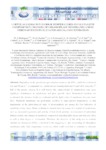Please use this identifier to cite or link to this item:
http://www.alice.cnptia.embrapa.br/alice/handle/doc/1068039| Title: | Coffee acclimation to high temperatures involves lipid composition changes of chloroplast membranes and is strenghtened by elevated air CO2 concentration. |
| Authors: | RODRIGUES, W. P.  MARTINS, M. Q.   FORTUNATO, A. S.   MARTINS, L. D.   PAIS, I. P.   COLWELL, F.   LEITÃO, A. E.   RODRIGUES, A. P.   CAMPOSTRINI, E.   GHINI, R.   |
| Affiliation: | W. P. RODRIGUES; M. Q. MARTINS; A. S. FORTUNATO; L. D. MARTINS; I. P. PAIS; F. COLWELL; A. E. LEITÃO; A. P. RODRIGUES; E. CAMPOSTRINI; RAQUEL GHINI, CNPMA. |
| Date Issued: | 2016 |
| Citation: | In: SEMANA NACIONAL DE CIÊNCIA E TECNOLOGIA, 13., 2016, Campos dos Goytacazes. Ciência alimentando o Brasil: [resumos...] Campos dos Goytacazes: IFFluminense; UENF; UFF, 2016. Pôster. |
| Description: | Depending on the greenhouse gas emission scenarios, air [CO2] could rise to between 421 and 936 ?L L-1, accompanied by a global surface warming between 0.3 and 4.8?C along the 2nd half of the present century. It is well known that supra-optimal air temperatures may cause significant disturbances in metabolism and plant growth, since biochemical reactions are accelerated, the chemical bonds are weakened and the lipid matrix of membranes becomes more fluid. Thylakoid membranes are particularly sensitive to supra-optimal temperatures, so that impairments at the photochemical steps of photosynthesis are among the first indicators of sensitivity to heat stress. Plants acclimate to thermal stress by means of a myriad of mechanisms, such as, increased expression and activity of heat shock proteins, reinforcement of antioxidant defense system, and changes in membrane composition regarding lipid classes and fatty acid (FA), as well as their degree of unsaturation. Therefore, the objective of this study was to evaluate whether the increase in [CO2] is involved in the triggering of lipid remodeling of chloroplasts membranes under high temperature conditions, which could contribute to maintain an adequate functional fluidity. Plants were grown for 1 year under controlled conditions (temperature, RH, irradiance, photoperiod), at 380 or 700 µL CO2 L-1 air, without nutrient, water and root space limitations, and then subjected to temperature increase (0.5 ºC/day) from 25/20 ºC (day/night) to 42/34ºC. Lipid classes were separated by thin layer chromatography on G60 silicagel plates and fatty acid methyl esters were analyzed by gas?liquid chromatography. The results suggested that regardless of [CO2], increases in temperature resulted in changes in lipid membranes composition, which could contribute to maintaining the functionality of thylakoid membranes. However, the mitigating effect of increased [CO2] on coffee photosynthetic apparatus at high temperatures observed earlier may be linked to stronger increases in saturation degree and/or with the increasing the weight of galactolipids classes at 37/30 °C (as compared to 380 µL CO2 L-1 plants). |
| NAL Thesaurus: | Fatty acids Chloroplasts Climate change Heat stress Lipids Pollution control |
| Type of Material: | Resumo em anais e proceedings |
| Access: | openAccess |
| Appears in Collections: | Resumo em anais de congresso (CNPMA)  |
Files in This Item:
| File | Description | Size | Format | |
|---|---|---|---|---|
| rodriguescoffee.pdf | 93.36 kB | Adobe PDF |  View/Open |









